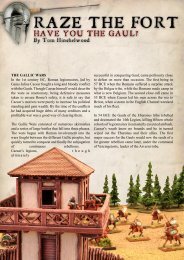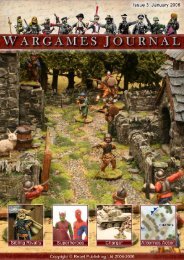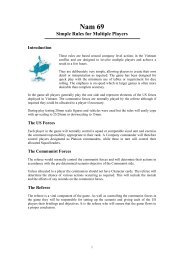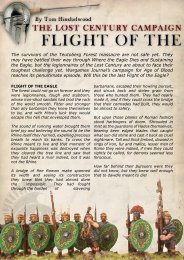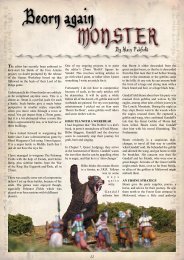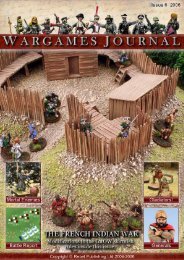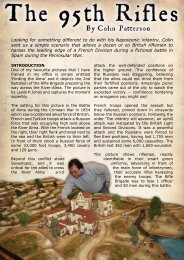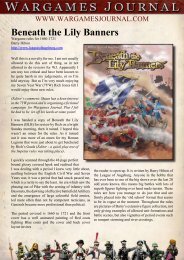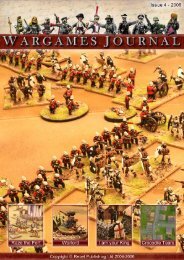The French Wars of Religion raged in France in the latter half of the ...
The French Wars of Religion raged in France in the latter half of the ...
The French Wars of Religion raged in France in the latter half of the ...
Create successful ePaper yourself
Turn your PDF publications into a flip-book with our unique Google optimized e-Paper software.
<strong>The</strong> <strong>French</strong> <strong>Wars</strong> <strong>of</strong> <strong>Religion</strong> <strong>raged</strong> <strong>in</strong> <strong>France</strong> <strong>in</strong> <strong>the</strong> <strong>latter</strong> <strong>half</strong> <strong>of</strong> <strong>the</strong> sixteenth century. Here we<br />
look at one <strong>of</strong> <strong>the</strong> open<strong>in</strong>g clashes between <strong>the</strong> <strong>French</strong> Catholics and <strong>the</strong> Protestant Huguenots.<br />
<strong>The</strong> battle <strong>of</strong> Dreux was fought on <strong>the</strong> 19th <strong>of</strong> December 1562 and Wargames Journal presents<br />
<strong>the</strong> scenario for <strong>the</strong> Armati rule system, but o<strong>the</strong>r rules can be used with <strong>the</strong> map, order <strong>of</strong><br />
battle and deployment <strong>in</strong>formation given here.<br />
BACKGROUND TO THE FRENCH WARS OF<br />
RELIGION<br />
Between 1562 and 1598 numerous civil wars would<br />
be fought between Catholic and Protestant forces <strong>in</strong><br />
<strong>France</strong>. Dur<strong>in</strong>g <strong>the</strong>se troubled times <strong>the</strong> widow <strong>of</strong><br />
Henry II was desperately try<strong>in</strong>g to reta<strong>in</strong> power <strong>in</strong><br />
<strong>the</strong> hands <strong>of</strong> <strong>the</strong> exist<strong>in</strong>g Valois monarchy. To do this<br />
Ca<strong>the</strong>r<strong>in</strong>e de Medici was quite capable <strong>of</strong> play<strong>in</strong>g one<br />
faction <strong>of</strong>f aga<strong>in</strong>st <strong>the</strong> next, regardless <strong>of</strong> <strong>the</strong>ir alleged<br />
religious affiliation.<br />
In 1562 <strong>the</strong> Protestant cause was championed by two<br />
men: <strong>the</strong> Pr<strong>in</strong>ce <strong>of</strong> Conde, Louis <strong>of</strong> Bourbon and <strong>the</strong><br />
Admiral <strong>of</strong> <strong>France</strong>, Gaspard de Coligny. In <strong>the</strong> early<br />
days <strong>the</strong> cause was seen as a way <strong>of</strong> combat<strong>in</strong>g <strong>the</strong><br />
power and perceived abuse demonstrated by <strong>the</strong><br />
Catholic Church. As <strong>the</strong> wider war dragged on and each<br />
new peace was aga<strong>in</strong> broken <strong>the</strong> Huguenot campaign<br />
became a fight for <strong>the</strong> survival <strong>of</strong> its exponents and<br />
<strong>the</strong> <strong>in</strong>itial idealism was gradually lost.<br />
This is illustrated <strong>in</strong> a way by <strong>the</strong> fact that Henry <strong>of</strong><br />
Navarre, <strong>the</strong> eventual K<strong>in</strong>g Henry IV, became <strong>the</strong><br />
leader <strong>of</strong> <strong>the</strong> Huguenot faction at <strong>the</strong> end <strong>of</strong> <strong>the</strong> wars<br />
but even he was eventually persuaded to undertake a<br />
pragmatic ‘abjuration’ which would allow him to be<br />
accepted back <strong>in</strong>to <strong>the</strong> Catholic fold.<br />
When <strong>the</strong> wars began <strong>the</strong> Catholic faction, or League<br />
as it was known, was controlled by <strong>the</strong> Guise family<br />
under Duke Francis and his bro<strong>the</strong>r <strong>the</strong> Card<strong>in</strong>al <strong>of</strong><br />
Lorra<strong>in</strong>e. <strong>The</strong> Catholic League believed firmly that<br />
<strong>the</strong> only good Protestant was a dead Protestant and<br />
were determ<strong>in</strong>ed to eradicate <strong>the</strong> Protestant heresy<br />
from <strong>France</strong>.<br />
<strong>The</strong> catalyst that started <strong>the</strong> wars and shattered <strong>the</strong><br />
uneasy alliance between <strong>the</strong> rival factions was when<br />
<strong>the</strong> ret<strong>in</strong>ue <strong>of</strong> <strong>the</strong> Duke <strong>of</strong> Guise murdered a Protestant<br />
church congregation <strong>in</strong> Vassey <strong>in</strong> March 1562.<br />
One <strong>of</strong> <strong>the</strong> o<strong>the</strong>r major factors which helped ignite<br />
<strong>the</strong> tension and fuel <strong>the</strong> wars was <strong>the</strong> fact that <strong>the</strong><br />
Italian wars so beloved by Henry II had ground to a<br />
halt <strong>in</strong> <strong>the</strong> 1540’s. As a result large numbers <strong>of</strong> tra<strong>in</strong>ed<br />
soldiers were roam<strong>in</strong>g around <strong>France</strong> with no source<br />
<strong>of</strong> employment nor any state mechanisms to ensure<br />
<strong>the</strong>y were looked after.<br />
As a result when <strong>the</strong> fight<strong>in</strong>g began <strong>the</strong>re was a ready<br />
source <strong>of</strong> man-power available for all sides with large<br />
numbers <strong>of</strong> men with no o<strong>the</strong>r trade than war ready<br />
and will<strong>in</strong>g to fight.<br />
<strong>The</strong> Catholic League effectively kidnapped <strong>the</strong> <strong>French</strong><br />
70
Royal family <strong>in</strong> order to ga<strong>in</strong> control <strong>of</strong> its military<br />
resources and while both sides awaited re<strong>in</strong>forcements<br />
from <strong>the</strong>ir respective foreign supporters (German<br />
troops for <strong>the</strong> Protestants and Spanish troops from<br />
<strong>the</strong> Ne<strong>the</strong>rlands for <strong>the</strong> Catholics) a series <strong>of</strong> small<br />
actions and skirmishes broke out across <strong>France</strong>.<br />
<strong>The</strong> Huguenot army conta<strong>in</strong>ed much <strong>of</strong> <strong>the</strong> m<strong>in</strong>or<br />
nobility and was always heavily reliant on its cavalry.<br />
<strong>The</strong> character <strong>of</strong> this force made its discipl<strong>in</strong>e very<br />
difficult to enforce with many soldiers reluctant to<br />
fight outside <strong>the</strong>ir home territory, <strong>the</strong>ir <strong>in</strong>st<strong>in</strong>ct was<br />
to preserve <strong>the</strong>ir estates from <strong>the</strong> attentions <strong>of</strong> any<br />
Catholic neighbours.<br />
Desertion was a constant problem, with many absent<strong>in</strong>g<br />
<strong>the</strong>mselves and return<strong>in</strong>g when <strong>the</strong>y wanted. <strong>The</strong> lack<br />
<strong>of</strong> discipl<strong>in</strong>e and <strong>the</strong> adherence to rank was to cause<br />
severe problems <strong>in</strong> <strong>the</strong> open<strong>in</strong>g campaign with many<br />
<strong>of</strong> <strong>the</strong> less glamorous duties <strong>of</strong> what was effectively<br />
a cavalry army be<strong>in</strong>g ignored - <strong>the</strong>re’s no glory <strong>in</strong> <strong>the</strong><br />
mundane tasks like scout<strong>in</strong>g after all!<br />
Throughout <strong>the</strong> wars <strong>the</strong> Protestant German states,<br />
led ma<strong>in</strong>ly by <strong>the</strong> Elector Palat<strong>in</strong>e would raise large<br />
numbers <strong>of</strong> armoured, pistol armed Reiters to serve<br />
<strong>the</strong> Protestant cause. Infantry was always second best<br />
<strong>in</strong> <strong>the</strong> Huguenot army until Henry <strong>of</strong> Navarre<br />
ga<strong>in</strong>ed access to <strong>the</strong>
esources <strong>of</strong> <strong>the</strong> Royal army towards <strong>the</strong> end <strong>of</strong> <strong>the</strong><br />
conflict and could afford to hire Swiss <strong>in</strong>fantry on a<br />
large scale.<br />
<strong>The</strong> Catholic cause, especially <strong>in</strong>itially, was supported<br />
by <strong>the</strong> resources <strong>of</strong> <strong>the</strong> Royal treasury and <strong>the</strong> contents<br />
<strong>of</strong> <strong>the</strong> Paris Arsenal. This meant that <strong>the</strong>y <strong>of</strong>ten had<br />
an advantage <strong>in</strong> artillery, although its effect on <strong>the</strong><br />
battlefield was still limited <strong>in</strong> comparison to later eras<br />
such as <strong>the</strong> Napoleonic.<br />
<strong>The</strong>ir solid foot was fur<strong>the</strong>r re<strong>in</strong>forced by <strong>the</strong> loan<br />
<strong>of</strong> several Spanish Tercios borrowed from <strong>the</strong><br />
Ne<strong>the</strong>rlands and <strong>the</strong> purchase <strong>of</strong> Swiss mercenary<br />
bands as required. Both sides resorted to <strong>the</strong> use <strong>of</strong><br />
paid mercenaries and both sides suffered as a result if<br />
<strong>the</strong> money was not available to pay <strong>the</strong>m. In this <strong>the</strong><br />
Catholics could generally afford to keep <strong>the</strong>ir armies<br />
toge<strong>the</strong>r for longer due to <strong>the</strong>ir access to <strong>the</strong> <strong>French</strong><br />
treasury.<br />
In addition to <strong>the</strong> Gendarmes, Reiters and Light<br />
Horse cavalry Stradiots were a true light cavalry that<br />
had evolved from a force <strong>of</strong> Alabanians created by<br />
<strong>the</strong> <strong>French</strong> dur<strong>in</strong>g <strong>the</strong> Italian wars. <strong>The</strong>y were armed<br />
with javel<strong>in</strong>s and shields and were <strong>of</strong>ten used as a<br />
light cavalry screen or as scouts. Argoulets were<br />
mounted Arquebusiers who could fire, probably not<br />
very effectively given <strong>the</strong> nature <strong>of</strong> <strong>the</strong> gun, from <strong>the</strong><br />
saddle.<br />
After <strong>in</strong>itial postur<strong>in</strong>g at <strong>the</strong> start <strong>of</strong> <strong>the</strong> campaign <strong>the</strong><br />
Huguenots marched on Paris look<strong>in</strong>g for battle but<br />
<strong>the</strong> Catholics refused <strong>the</strong> fight. When <strong>the</strong> Protestant<br />
force began mov<strong>in</strong>g away towards <strong>the</strong> coast to await<br />
<strong>the</strong> arrival <strong>of</strong> some promised re<strong>in</strong>forcements from<br />
England Montmorency, <strong>the</strong> Constable <strong>of</strong> <strong>France</strong> and<br />
leader <strong>of</strong> <strong>the</strong> Catholic army, decided to give chase.<br />
After mov<strong>in</strong>g past his opponent Montmorency cut<br />
across <strong>the</strong> Huguenot commander, <strong>the</strong> Pr<strong>in</strong>ce <strong>of</strong><br />
Conde’s, l<strong>in</strong>e <strong>of</strong> advance near <strong>the</strong> town <strong>of</strong> Dreux.<br />
For a full description <strong>of</strong> <strong>the</strong> battle and <strong>the</strong> campaign<br />
please refer to <strong>the</strong> bibliography for a list <strong>of</strong> books that<br />
will give a more comprehensive and accurate view <strong>of</strong><br />
both.<br />
THE BATTLE OF DREUX<br />
<strong>The</strong> Huguenot advance towards Le Havre began on<br />
<strong>the</strong> 9th <strong>of</strong> December 1562. <strong>The</strong> advance cont<strong>in</strong>ued<br />
towards Rouen as Montmorency left Paris and<br />
followed Conde’s army north.<br />
After cross<strong>in</strong>g Conde’s path undetected Montmorency<br />
set up camp near Dreux ready to block <strong>the</strong> Protestant<br />
advance between <strong>the</strong> villages <strong>of</strong> Bla<strong>in</strong>ville and<br />
Ep<strong>in</strong>ay.<br />
Despite his superiority <strong>in</strong> cavalry Conde failed to<br />
detect <strong>the</strong> presence <strong>of</strong> <strong>the</strong> Catholic army and was<br />
totally surprised when his force marched <strong>in</strong>to <strong>the</strong><br />
prepared Catholic army deployed to his front.<br />
On <strong>the</strong> Catholic left flank was <strong>the</strong> Bois de la Place and<br />
<strong>the</strong> Bois de la Chanteloup beyond which was <strong>the</strong> river<br />
Eure. Beh<strong>in</strong>d this flank was <strong>the</strong> village <strong>of</strong> Bla<strong>in</strong>ville<br />
and beyond this was <strong>the</strong> Catholic camp.<br />
On <strong>the</strong> Catholic right flank was <strong>the</strong> Bois de la<br />
Marmousse backed by <strong>the</strong> River Blaise and on this<br />
flank also stood <strong>the</strong> fortified village <strong>of</strong> Ep<strong>in</strong>ay. Runn<strong>in</strong>g<br />
between <strong>the</strong> two villages and head<strong>in</strong>g towards Dreux<br />
was <strong>the</strong> road along which <strong>the</strong> Pr<strong>in</strong>ce <strong>of</strong> Conde was<br />
lead<strong>in</strong>g his army.<br />
Montmorency deployed his army <strong>in</strong> two dist<strong>in</strong>ct parts.<br />
<strong>The</strong> Vanguard was commanded by St Andre, <strong>the</strong><br />
Marshal <strong>of</strong> <strong>France</strong>. <strong>The</strong> Ma<strong>in</strong> Battle was commanded<br />
by Montmorency himself and was deployed <strong>in</strong> a<br />
s<strong>in</strong>gle l<strong>in</strong>e between <strong>the</strong> two villages. <strong>The</strong> Vanguard<br />
was deployed <strong>in</strong> and around <strong>the</strong> fortified village <strong>of</strong><br />
Ep<strong>in</strong>ay.<br />
Conde deployed a Vanguard under <strong>the</strong> command <strong>of</strong><br />
Coligny and a Ma<strong>in</strong> Battle under his own command.<br />
Unlike Montmorencey Conde deployed his force<br />
<strong>in</strong> several l<strong>in</strong>es and ensured that he had sufficient<br />
reserves available should <strong>the</strong>y be required. Aga<strong>in</strong> poor<br />
scout<strong>in</strong>g was probably <strong>in</strong> evidence as Conde appears<br />
to have been unaware <strong>of</strong> <strong>the</strong> forces deployed around<br />
Ep<strong>in</strong>ay until <strong>the</strong> battle began and as a result he only<br />
deployed <strong>in</strong> front <strong>of</strong> <strong>the</strong> Catholic Ma<strong>in</strong> Battle.<br />
Conde did not want to attack <strong>the</strong> prepared Catholic<br />
position but was also aware that he could not conduct<br />
a withdrawal safely as he was so close to <strong>the</strong> enemy<br />
l<strong>in</strong>e.<br />
After a lull for <strong>the</strong> rest <strong>of</strong> <strong>the</strong> morn<strong>in</strong>g Conde realised<br />
that Montmorency would not leave his position to<br />
attack. Around noon he decided to move towards <strong>the</strong><br />
left <strong>in</strong> an attempt to move around <strong>the</strong> Catholic flank.<br />
No sooner had <strong>the</strong> Huguenots begun to move <strong>the</strong>n<br />
<strong>the</strong> Catholics started to advance. Conde stopped his<br />
manoeuvre and quickly ordered his army to change<br />
72
its fac<strong>in</strong>g aga<strong>in</strong> and move towards <strong>the</strong> enemy<br />
Sensibly ignor<strong>in</strong>g <strong>the</strong> fortifications <strong>in</strong> Ep<strong>in</strong>ay <strong>the</strong><br />
Huguenot charge swept away <strong>the</strong> oppos<strong>in</strong>g cavalry<br />
on <strong>the</strong> Catholic left flank and managed to capture<br />
both <strong>the</strong> Constable <strong>of</strong> <strong>France</strong>, Montmorency and <strong>the</strong><br />
village <strong>of</strong> Bla<strong>in</strong>ville. In <strong>the</strong> f<strong>in</strong>est tradition <strong>of</strong> cavalry<br />
through <strong>the</strong> ages Coligny’s victorious horse <strong>the</strong>n<br />
cont<strong>in</strong>ued <strong>the</strong>ir charge and began loot<strong>in</strong>g <strong>the</strong> Catholic<br />
camp located beh<strong>in</strong>d this flank.<br />
Meanwhile on <strong>the</strong> Protestant left flank Conde<br />
stormed his cavalry <strong>in</strong>to <strong>the</strong> mass <strong>of</strong> Swiss foot but<br />
failed to break <strong>the</strong>m. St Andre sent two companies<br />
<strong>of</strong> Gendarmes to support <strong>the</strong> gallant Swiss but <strong>the</strong>se<br />
were broken by <strong>the</strong> Reiters posted by Conde to deflect<br />
<strong>the</strong>m.<br />
<strong>The</strong> Gendarmes were heavy cavalry <strong>in</strong> every sense,<br />
armed with a lance and elaborate expensive armour<br />
for both <strong>the</strong> rider and <strong>the</strong> horse. <strong>The</strong> Gendarmes<br />
considered <strong>the</strong>mselves <strong>the</strong> successors to <strong>the</strong> medieval<br />
knight.<br />
Unlike <strong>the</strong> s<strong>in</strong>gle rank full blooded charge favoured<br />
by <strong>the</strong> Gendarmes <strong>the</strong> pistol armed Reiters operated<br />
<strong>in</strong> deep formations and <strong>of</strong>ten charged at <strong>the</strong> trot to<br />
ma<strong>in</strong>ta<strong>in</strong> <strong>the</strong>ir close order. Favour<strong>in</strong>g <strong>the</strong> ‘caracole’<br />
technique <strong>the</strong>y would discharge <strong>the</strong>ir pistols rank<br />
by rank, each successive rank trott<strong>in</strong>g to <strong>the</strong> rear to<br />
<strong>The</strong> battle l<strong>in</strong>es are drawn. Figures from our 15mm collection and image taken dur<strong>in</strong>g playtest<strong>in</strong>g <strong>the</strong> scenario.<br />
74
eload before mov<strong>in</strong>g forward aga<strong>in</strong>. This could be a<br />
risky technique aga<strong>in</strong>st cavalry if <strong>the</strong> pistol fire failed<br />
to stop an enemy charge!<br />
<strong>The</strong> refusal <strong>of</strong> <strong>the</strong> Swiss to break was more than<br />
<strong>the</strong> rash Conde could stand and he became fixated<br />
with rout<strong>in</strong>g <strong>the</strong> Swiss formation. Order<strong>in</strong>g his<br />
Landsknechts to attack <strong>the</strong> scene was set for a bloody<br />
confrontation between <strong>the</strong>se two bitter rivals.<br />
<strong>The</strong> <strong>in</strong>fantry on both sides was armed with a mixture<br />
<strong>of</strong> both pike and shot. <strong>The</strong> Protestant armies were<br />
usually deficient <strong>in</strong> resources and so <strong>of</strong>ten attached<br />
<strong>French</strong> Arquebusiers to units <strong>of</strong> Swiss or Landsknecht<br />
pike. In contrast to <strong>the</strong> deficiencies with <strong>the</strong> Huguenot<br />
foot <strong>the</strong> Catholic League could call on <strong>the</strong> ‘Old Bands’,<br />
<strong>the</strong> veteran <strong>in</strong>fantry that had served Henry II dur<strong>in</strong>g<br />
<strong>the</strong> Italian wars, and because <strong>the</strong>y could pay <strong>the</strong>m on<br />
a regular basis <strong>the</strong>ir companies could stay toge<strong>the</strong>r<br />
for much longer than was <strong>the</strong> case <strong>in</strong> <strong>the</strong> Huguenot<br />
army.<br />
In <strong>the</strong> central clash between <strong>the</strong> Swiss and <strong>the</strong> German<br />
Landsknechts <strong>the</strong> Swiss emerged triumphant and it<br />
was <strong>the</strong> Landsknechts who gave way. In a fury Conde<br />
ordered his last reserve <strong>of</strong> Gendarmes <strong>in</strong>to <strong>the</strong> attack<br />
but <strong>the</strong>se also failed to budge <strong>the</strong> stubborn Swiss.<br />
At this po<strong>in</strong>t St Andre, accompanied by <strong>the</strong> Duke <strong>of</strong><br />
Guise, ordered his entire force to attack. <strong>The</strong> <strong>French</strong><br />
foot was immediately routed and <strong>the</strong> Landsknechts<br />
surrendered. Conde charged at <strong>the</strong> head <strong>of</strong> a few<br />
rallied cavalry but was captured himself, mak<strong>in</strong>g both<br />
oppos<strong>in</strong>g commanders prisoners <strong>in</strong> <strong>the</strong> same battle!<br />
Meanwhile Coligny had f<strong>in</strong>ally succeeded <strong>in</strong><br />
ga<strong>the</strong>r<strong>in</strong>g some <strong>of</strong> <strong>the</strong> pillag<strong>in</strong>g cavalry back toge<strong>the</strong>r<br />
and attempted to charge St Andre’s force, which<br />
was surprised and ridden down. This time it was St.<br />
Andre’s turn to be captured.<br />
Coligny’s cavalry was known as ‘Chevauxleger’.<br />
<strong>The</strong>se so called ‘light horse’ were <strong>in</strong> fact heavy cavalry<br />
<strong>the</strong>mselves. Descended from <strong>the</strong> reta<strong>in</strong>ers kept on by<br />
<strong>the</strong> Medieval Knights and later <strong>the</strong> Gendarmes <strong>the</strong>y<br />
were still armoured - just less so than <strong>the</strong>ir expensive<br />
brethren <strong>the</strong> Gendarmes.<br />
Despite this success <strong>the</strong> Huguenots could not budge<br />
<strong>the</strong> Catholic foot from <strong>the</strong> fortified Epernay and so<br />
<strong>the</strong>y withdrew from <strong>the</strong> battlefield.<br />
With no Catholic reserve to speak <strong>of</strong> <strong>the</strong> Huguenot<br />
withdrawal was successful and unhurried. A series<br />
<strong>of</strong> sieges <strong>the</strong>n ensued and with <strong>the</strong> peace <strong>of</strong> Amboise<br />
be<strong>in</strong>g signed <strong>in</strong> March 1563 <strong>the</strong> first <strong>of</strong> <strong>the</strong> civil wars<br />
came to an end.<br />
THE SCENARIO<br />
This was a battle that <strong>the</strong> Protestant leader <strong>the</strong> Pr<strong>in</strong>ce<br />
<strong>of</strong> Conde, could have avoided if he had used <strong>the</strong><br />
Huguenots superior cavalry advantage to good effect<br />
and performed a proper reconnaissance.<br />
<strong>The</strong> battle was <strong>in</strong>fluenced by <strong>the</strong> lack <strong>of</strong> a Catholic<br />
reserve that meant <strong>the</strong>y could not exploit any success<br />
properly. Ano<strong>the</strong>r significant factor <strong>in</strong> <strong>the</strong> battle was<br />
<strong>the</strong> quality <strong>of</strong> <strong>the</strong> Swiss foot, which stoically resisted<br />
all that Conde could throw at it.<br />
<strong>The</strong> map shows <strong>the</strong> terra<strong>in</strong> and historical deployment<br />
zones bordered by <strong>the</strong> villages <strong>of</strong> Epernay and<br />
Bla<strong>in</strong>ville. Only Epernay was fortified. Also shown<br />
are <strong>the</strong> woods and rivers present on both flanks. None<br />
<strong>of</strong> <strong>the</strong> woods played a part <strong>in</strong> <strong>the</strong> battle and should<br />
probably be considered as difficult terra<strong>in</strong> for both<br />
<strong>in</strong>fantry and cavalry.<br />
<strong>The</strong> orders <strong>of</strong> battle show <strong>the</strong> strengths <strong>of</strong> each <strong>of</strong> <strong>the</strong><br />
historical types <strong>of</strong> unit present at <strong>the</strong> battle and also a<br />
guide for how <strong>the</strong>se were deployed as discrete units.<br />
Each unit has been allocated a letter which corresponds<br />
to its historical deployment on <strong>the</strong> scenario map.<br />
<strong>The</strong> orders <strong>of</strong> battle have been converted <strong>in</strong>to<br />
appropriate Armati units <strong>in</strong> <strong>the</strong> download section. <strong>The</strong><br />
download section also provides <strong>the</strong> army statistics and<br />
combat values <strong>of</strong> each <strong>of</strong> <strong>the</strong> units <strong>in</strong>volved.<br />
<strong>The</strong> army lists are based on those <strong>in</strong> <strong>the</strong> Advanced<br />
Armati supplement written by Arty Conliffe but <strong>the</strong>y<br />
do not strictly follow <strong>the</strong> normal army limitations.<br />
Each division is treated as a separate army for<br />
purposes <strong>of</strong> Break po<strong>in</strong>t, so <strong>the</strong> Huguenot Vanguard<br />
under Coligny could break before <strong>the</strong> Ma<strong>in</strong> Battle<br />
under Conde, however for <strong>the</strong> purposes <strong>of</strong> movement<br />
both Huguenot or Catholic divisions will move if <strong>the</strong>ir<br />
side w<strong>in</strong>s <strong>the</strong> <strong>in</strong>itiative.<br />
No <strong>in</strong>crease has been made <strong>in</strong> <strong>the</strong> command rat<strong>in</strong>gs<br />
<strong>of</strong> ei<strong>the</strong>r side which may cause a problem with uncommanded<br />
heavy divisions, particularly for <strong>the</strong><br />
player tak<strong>in</strong>g on <strong>the</strong> role <strong>of</strong> St Andre.<br />
<strong>The</strong> army breakpo<strong>in</strong>t has been calculated by simply<br />
divid<strong>in</strong>g <strong>the</strong> total number <strong>of</strong> key units <strong>in</strong> each division<br />
75
y two. You can be more creative with this if you want<br />
to, but we f<strong>in</strong>d that this method works well.<br />
If <strong>the</strong> game is to be played us<strong>in</strong>g o<strong>the</strong>r element based<br />
rules systems such as DBR <strong>the</strong>n simply determ<strong>in</strong>e a<br />
scale by which to divide <strong>the</strong> strengths given <strong>in</strong> <strong>the</strong><br />
order <strong>of</strong> battle to determ<strong>in</strong>e <strong>the</strong> number <strong>of</strong> bases<br />
to use <strong>in</strong> each unit. For example if <strong>the</strong> scale is 300<br />
Montmorency should have a force <strong>of</strong> 3 Gendarme<br />
bases <strong>in</strong> his Ma<strong>in</strong> Battle.<br />
THE CATHOLIC OBJECTIVE, ORDER OF<br />
BATTLE AND DEPLOYMENT<br />
Montmorency must prevent <strong>the</strong> Huguenots from<br />
break<strong>in</strong>g through and cont<strong>in</strong>u<strong>in</strong>g <strong>the</strong>ir advance to <strong>the</strong><br />
coast and <strong>the</strong> wait<strong>in</strong>g English re<strong>in</strong>forcements. <strong>The</strong><br />
Catholic cause is lost if both <strong>the</strong> Vanguard and Ma<strong>in</strong><br />
battle break.<br />
Catholic Order <strong>of</strong> Battle:<br />
Vanguard; St. Andre<br />
1,200 Gendarmes (Units A, B and C)<br />
3,700 <strong>French</strong> Foot (Unit D)<br />
2,200 Spanish Foot (Unit E)<br />
1,700 Landsknechts (Unit F)<br />
14 Guns (Unit G)<br />
St Andre deployed with one <strong>of</strong> <strong>the</strong> three Gendarme<br />
units, Unit B, each <strong>of</strong> which was around 400 strong.<br />
Ma<strong>in</strong> Battle; Montmorency<br />
860 Gendarmes d’Ord<strong>in</strong>ance (Unit H)<br />
300 Argoulets (Unit I)<br />
3,700 <strong>French</strong> Foot (Unit J)<br />
4,700 Swiss Foot (Unit K)<br />
8 Guns (Unit L)<br />
Montmorency deployed with <strong>the</strong> Gendarmes<br />
d’Ord<strong>in</strong>ance.<br />
THE HUGUENOT OBJECTIVE, ORDER OF<br />
BATTLE AND DEPLOYMENT<br />
Conde must sweep away <strong>the</strong> block<strong>in</strong>g Catholic force<br />
<strong>in</strong> order to cont<strong>in</strong>ue his advance on Le Havre. <strong>The</strong><br />
Huguenot cause is lost if both <strong>the</strong> Vanguard and Ma<strong>in</strong><br />
battle break.<br />
Huguenot Order <strong>of</strong> Battle:<br />
Vanguard; Coligny<br />
600 Light Horse (Unit 1)<br />
1,000 Reiters (Unit 2)<br />
2,800 <strong>French</strong> Foot (Unit 3)<br />
1,500 Landsknechts (Unit 4)<br />
Coligny was present with <strong>the</strong> ‘light horse’, Unit 1.<br />
Ma<strong>in</strong> Battle; Conde<br />
500 Gendarmes (Units 5 and 6)<br />
400 Argoulets (Unit 7)<br />
1,500 Reiters (Unit 8)<br />
3,100 <strong>French</strong> Foot (Unit 9)<br />
1,500 Landsknechts (Unit 10)<br />
Conde was with <strong>the</strong> lead<strong>in</strong>g unit <strong>of</strong> Gendarmes,<br />
unit 5. This was <strong>the</strong> larger <strong>of</strong> his two heavy cavalry<br />
units. <strong>The</strong> reserve unit, Unit 6, was commanded by<br />
Rochfoucault and was to be Conde’s last throw <strong>of</strong><br />
<strong>the</strong> dice <strong>in</strong> his attempt to smash <strong>the</strong> stubborn Swiss<br />
<strong>in</strong>fantry.<br />
BIBLIOGRAPHY<br />
A History <strong>of</strong> <strong>the</strong> Art <strong>of</strong> War <strong>in</strong> <strong>the</strong> Sixteenth Century<br />
by Sir Charles Oman, Greenhill Books.<br />
Rennaissance Battles 1494-1700 by Peter Sides,<br />
Gosl<strong>in</strong>g Press.<br />
<strong>The</strong> <strong>French</strong> <strong>Wars</strong> <strong>of</strong> <strong>Religion</strong> 1562 - 1598, a wargamers<br />
guide by Ray Lucas, <strong>The</strong> Battery Press<br />
Armati and Advanced Armati - Rules and Lists for<br />
Ancient, Medieval & Renaissance Wargam<strong>in</strong>g by<br />
Arty Conliffe<br />
DOWNLOADS<br />
<strong>The</strong> follow<strong>in</strong>g l<strong>in</strong>ks will take you to PDFs on <strong>the</strong><br />
Wargames Journal web site which conta<strong>in</strong> <strong>the</strong> key<br />
elements <strong>of</strong> this scenario: Orbats and Special/Scenario<br />
rules. Simply click on <strong>the</strong> one you want to view or<br />
download:<br />
• Catholic Order <strong>of</strong> Battle<br />
• Huguenot Order <strong>of</strong> Battle<br />
76




